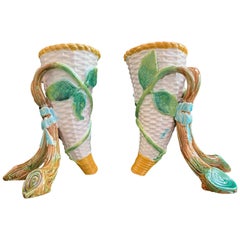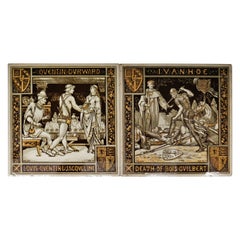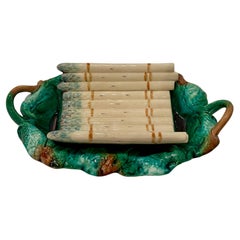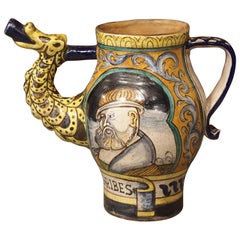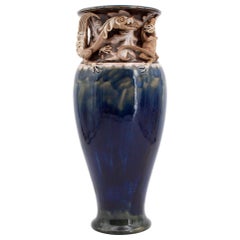Earthenware Ceramics
1870s English Victorian Antique Earthenware Ceramics
Majolica
Late 19th Century English Victorian Antique Earthenware Ceramics
Ceramic, Earthenware
19th Century French Antique Earthenware Ceramics
Majolica
Early 20th Century Italian Renaissance Earthenware Ceramics
Majolica
Late 19th Century British Art Nouveau Antique Earthenware Ceramics
Earthenware
Mid-18th Century English George III Antique Earthenware Ceramics
Creamware
Late 19th Century British Aesthetic Movement Antique Earthenware Ceramics
Earthenware
1960s Spanish Mid-Century Modern Vintage Earthenware Ceramics
Majolica, Ceramic
19th Century English Victorian Antique Earthenware Ceramics
Majolica
1980s Italian Vintage Earthenware Ceramics
Maiolica
Early 20th Century French Earthenware Ceramics
Faience
1890s French Medieval Antique Earthenware Ceramics
Earthenware, Pottery
1930s Swedish Scandinavian Modern Vintage Earthenware Ceramics
Earthenware
18th Century Italian Antique Earthenware Ceramics
Majolica
1910s French Art Deco Vintage Earthenware Ceramics
Ceramic, Majolica
2010s American Arts and Crafts Earthenware Ceramics
Ceramic, Clay, Earthenware, Porcelain, Stoneware
1770s Italian Rococo Antique Earthenware Ceramics
Maiolica
1970s German Mid-Century Modern Vintage Earthenware Ceramics
Earthenware
1770s Italian Chinoiserie Antique Earthenware Ceramics
Maiolica
19th Century British Victorian Antique Earthenware Ceramics
Majolica
18th Century Italian Antique Earthenware Ceramics
Maiolica
19th Century English Victorian Antique Earthenware Ceramics
Ceramic, Majolica
1860s English Victorian Antique Earthenware Ceramics
Earthenware, Majolica, Pottery
1880s French Rustic Antique Earthenware Ceramics
Ceramic, Majolica
Mid-20th Century Italian Earthenware Ceramics
Maiolica
1770s Italian Neoclassical Antique Earthenware Ceramics
Maiolica
1770s Italian Rococo Antique Earthenware Ceramics
Maiolica
Early 20th Century English Earthenware Ceramics
Majolica
19th Century English Victorian Antique Earthenware Ceramics
Ceramic, Majolica
1770s Italian Rococo Antique Earthenware Ceramics
Maiolica
1960s Danish Scandinavian Modern Vintage Earthenware Ceramics
Faience
1960s Danish Scandinavian Modern Vintage Earthenware Ceramics
Faience
19th Century English Victorian Antique Earthenware Ceramics
Ceramic, Majolica, Earthenware
Late 20th Century English Victorian Earthenware Ceramics
Majolica
Early 1700s Italian Baroque Antique Earthenware Ceramics
Maiolica
1950s Italian Mid-Century Modern Vintage Earthenware Ceramics
Ceramic, Maiolica, Pottery
1870s French Japonisme Antique Earthenware Ceramics
Faience
Early 19th Century English George III Antique Earthenware Ceramics
Earthenware
19th Century British Antique Earthenware Ceramics
Earthenware
Late 18th Century Antique Earthenware Ceramics
Maiolica
Late 19th Century English Aesthetic Movement Antique Earthenware Ceramics
Earthenware
1770s Italian Rococo Antique Earthenware Ceramics
Maiolica
1920s Austrian Art Deco Vintage Earthenware Ceramics
Earthenware
Late 19th Century French Country Antique Earthenware Ceramics
Earthenware
Late 19th Century French Japonisme Antique Earthenware Ceramics
Faience
21st Century and Contemporary Italian Modern Earthenware Ceramics
Ceramic, Majolica
1960s French Mid-Century Modern Vintage Earthenware Ceramics
Earthenware, Pottery
21st Century and Contemporary Italian Modern Earthenware Ceramics
Platinum
1870s French Aesthetic Movement Antique Earthenware Ceramics
Faience
1770s Italian Rococo Antique Earthenware Ceramics
Maiolica
Mid-20th Century Swedish Scandinavian Modern Earthenware Ceramics
Ceramic, Earthenware
19th Century Italian Rococo Antique Earthenware Ceramics
Majolica
1920s French Art Deco Vintage Earthenware Ceramics
Earthenware
1870s Antique Earthenware Ceramics
Majolica
Mid-20th Century Portuguese Mid-Century Modern Earthenware Ceramics
Earthenware
Late 19th Century French Art Nouveau Antique Earthenware Ceramics
Ceramic, Earthenware, Majolica
1870s English Victorian Antique Earthenware Ceramics
Earthenware, Majolica, Pottery
1950s French Art Deco Vintage Earthenware Ceramics
Ceramic, Earthenware
Late 19th Century Swiss Antique Earthenware Ceramics
Faience, Wood
Mid-20th Century Danish Scandinavian Modern Earthenware Ceramics
Faience
